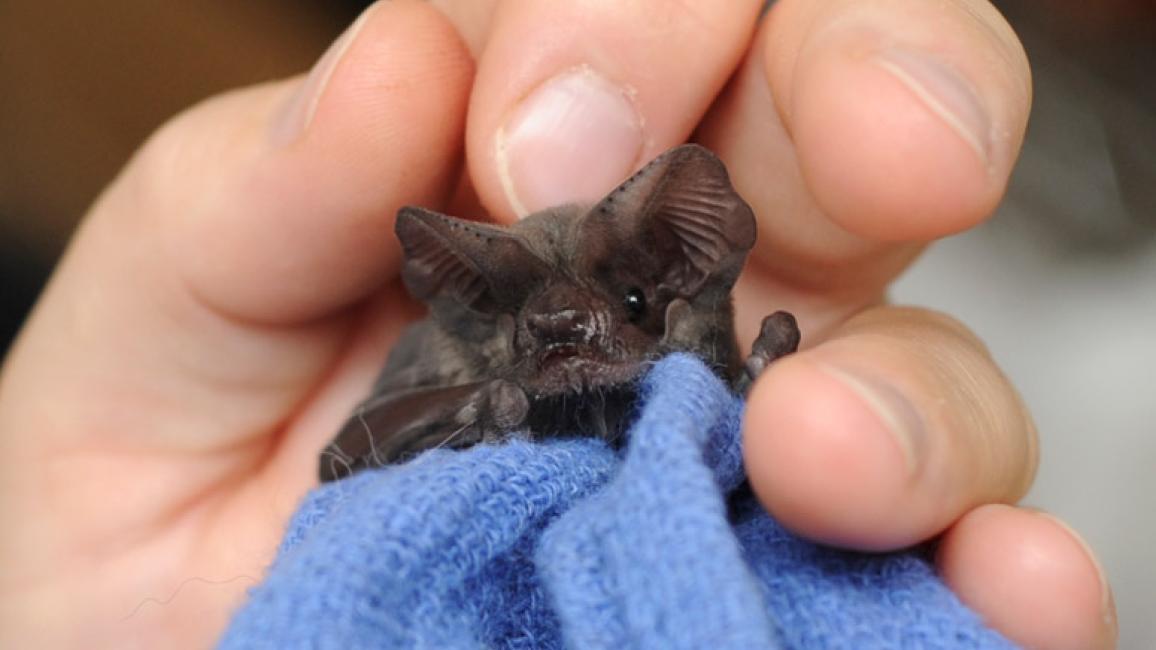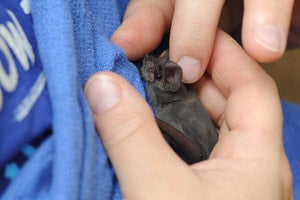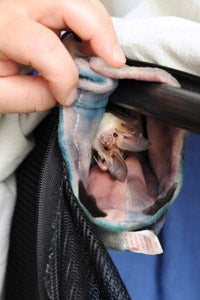Caring for Brazilian free-tailed bats and a pallid bat

A short time ago, a bat baby showed up at Wild Friends unexpectedly.
After being found by a hiker on one of the canyon trails near Kanab two months earlier, his mom had come to Wild Friends. This was during a sudden cold snap, when all the insects had gone back into hiding. She was found on the ground, too cold and hungry to fly.
She arrived around midday, and Carmen Smith, manager of Wild Friends and licensed wildlife rehabilitator, had soon taught her how to feed herself in captivity.
 Bat gives birth to baby
Bat gives birth to baby
A couple of weeks ago, a lot of squeaks, chips and chitters were emerging from the bat's room. When Carmen went in to check on her, she found two bats instead of one. Mom had given birth to a baby.
Both were doing fine. They called back and forth to each other for the next 24 hours, and they enjoyed hanging upside down next to each other. Mom was able to nurse the baby at first, but then she needed a little extra help from Carmen, who provided supplemental feeding by wrapping the baby in a towel and offering him a sponge soaked in milk - not the kind of milk bought in a grocery store, but a special formula designed with bats in mind.
Learn more about wildlife rehabilitation at Best Friends
Brazilian free-tailed bats
 Mom and baby, who are both Brazilian free-tailed bats, are living in an environment with 90 degree heat and 90 percent humidity. The baby should be releasable back to the wild, and Mom has a beautiful home with other bats waiting for her, if needed. Mom is getting a lot of good exercise. If she regains her full flying strength, then she'll be released too. If not, perhaps due to an undetectable weakness or injury, then she will go to Bat World in Texas to live happily in a colony there.
Mom and baby, who are both Brazilian free-tailed bats, are living in an environment with 90 degree heat and 90 percent humidity. The baby should be releasable back to the wild, and Mom has a beautiful home with other bats waiting for her, if needed. Mom is getting a lot of good exercise. If she regains her full flying strength, then she'll be released too. If not, perhaps due to an undetectable weakness or injury, then she will go to Bat World in Texas to live happily in a colony there.
Injured pallid bat
In the meantime, both bats have a new bat friend. A man who studies and writes about the world of nature found a pallid bat (they're a bit bigger than Brazilian free-tailed bats) outside, near his house in the Kanab area.
The Utah Division of Wildlife Resources referred him to Wild Friends at Best Friends, and he arrived with the bat in a nice, safe little container. He said he brought the bat because he wanted to be sure the little bat would receive good care.
The newcomer was not very stable when he arrived, and Carmen gave him fluids and oxygen therapy. When he had perked up a little, she was able to examine him and found that his right wing had an old fracture. He could not have been flying with that kind of an injury. Maybe he was injured as a baby before he was weaned, then when he was old enough to take flight, he wasn't able to fly and was found on the ground by his rescuer. That could explain why the injury was an old one.
If he is not releasable, he too will have a place where he can live a happy life at Bat World in Texas.
Wildlife rehabilitators
If you ever find a bat on the ground, first call a licensed wildlife rehabilitator for advice. While you can pick up a baby bird with your hands, it's not safe to touch a bat with your hands. A small towel can be used to pick up the bat gently and put him into a cardboard box that has air holes in it. For further instructions, check with a wildlife rehabilitator, and transport the bat to her or him.
For help finding a rehabilitator near you, call Wild Friends, at Best Friends: 435-644-2001, ext 4460.
Photos by Molly Wald